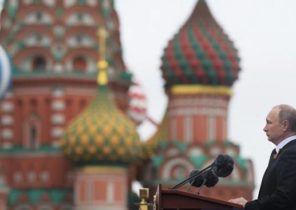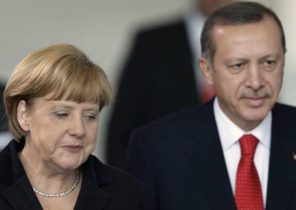I used to think that the US and Russia may create a strategic Alliance like the one that defeated Nazi Germany. I thought that Washington and Moscow could work together to become the world’s “policemen” to maintain world order and keep the peace.
I was wrong and, worse, was naive.
Since 1917, the goal was to offer the peoples of the world an alternative to the liberal democracy of the Western sample. In the international arena are the main currency of political and economic power. Moscow’s economy has always been weak, so she was forced to achieve this goal through military force. Under Vladimir Putin in Russia’s foreign policy is Central to aggressive expansionism.
A good example is Afghanistan. For Moscow, the Republic of the Average (Central) Asia is of great strategic importance. First, the elites of the republics of Central Asia, which owed their political status to the Soviet system, took the collapse of the Soviet Union without much enthusiasm. Suddenly faced with the possibility that they will go into oblivion, these elites to stay in power, adopted a nationalist rhetoric. Since the Central Asian republics remained under the control of former customers of Moscow, their relations with Russia and continued after the collapse of the Soviet Union, but still, the Kremlin was dealt a serious blow: he never claimed to be huge reserves of important natural resources of the republics. And since one of the main goals of Russian foreign policy was the preservation of a monopoly on the export and transportation of hydrocarbons in the former Soviet Union.
The independence of the Central Asian republics had another consequence: it gave the United States the opportunity to assert its influence in the “backyard” of Russia. Republic took advantage of new political borders in the region, seeking to reduce its dependence on Moscow, while remaining on good terms with both parties in the geopolitical conflict. Western oil companies wanted to take advantage of the regional market, while Turkmenistan wanted to build a pipeline through Afghanistan to Pakistan. Washington pressured Turkmenistan, that he commissioned the construction of the pipeline of the American Corporation Unocal (Unocal). He then took steps to start talks with Afghanistan and Pakistan. The geopolitical stakes in this well-thought-out maneuver were high: if successful, Washington would strengthen its relations with Pakistan, an old ally, and possibly even purchased a new (though unlikely) friend in Afghanistan, which never entered into the sphere of his influence. The development of gas fields in Turkmenistan, American business giants have also contributed to the establishment of harmonious relations between the United States and the Central Asian republics of Turkmenistan and Uzbekistan.
By the time the United States realized the undeniable importance of Afghanistan for the production of gas and oil in Central Asia: the construction of pipelines through Afghanistan allowed to circumvent Iran, which since 1979 is the enemy of the United States. But in order to use the Afghan territory, it was necessary to establish a sufficiently stable relationship with the Taliban (a terrorist organization banned in Russia — approx. ed.), who ruled the country. Trying to thwart the plans of America, Russia continued construction of a pipeline to the North through Kazakhstan and Eastern Russia. This task was hampered by rampant corruption, with regard to Washington’s plans, they were not performed because of worsening relations with the Taliban.
But the true strategic value of Central Asia, the United States realized only after the terrorist attacks of September 11. When the United States decided to send troops to Afghanistan as a springboard for attacks they had three options: Iran, Pakistan and Central Asia. The choice fell on Central Asia. The United States and Europe successfully pressured Russia to assist in the creation of a supply of goods, although Moscow risked losing influence in the region, which it considered part of its sphere of influence. In the period from 2011 to 2015, approximately half of the supply of goods to NATO forces in Afghanistan was implemented through a result, the Northern distribution network, although their direction through Pakistan would be cheaper. Thus, the United States secured a military presence in the backyard of Russia, breaking the tradition according to which the presence of American or NATO troops in countries that were part of the Russian sphere of influence, was prohibited.
Russia made a big strategic mistake. The US invasion of Afghanistan and expanding relations of Washington with a post-USSR republics of Central Asia were a threat to the plans of Putin. In 2003, Russia opened a military base in Kyrgyzstan, promising that will not leave the region under US control. Since then the Central Asian republics are hesitating between neutrality (Turkmenistan) and active cooperation (Uzbekistan). They are easily susceptible to intimidation from Moscow and still fear that exists in Afghanistan, the instability can spread beyond this country on their territory. Therefore, to overcome these threats, they seek to create alliances. For all these republics, except Tajikistan, which has decided to deepen its relations with Russia, it means strengthening ties with the US.
It is in this light that we must consider the recent sensational news that the Russian GRU allegedly offered to pay the Taliban for killing American troops in Afghanistan. One explanation for the alleged actions of Russia is that the Kremlin believes the Taliban are relatively reasonable protection against the spread of the forces of ISIS (a terrorist organization banned in Russia — approx. ed.) and “al-Qaeda” (the terrorist organization banned in Russia — approx. ed.). Not much point in this, since the difference between the Taliban and these organizations, to put it mildly, fuzzy. But another reason seems clear: Moscow wants to create leverage in the current Afghan government, levers that it can use in that case, if the President trump will achieve your goal and withdraw U.S. troops from the country. Supporting the Taliban, Moscow could potentially play a role in determining Afghanistan’s future, and will be able to take control of the transportation of hydrocarbons in the region.
Moscow wants to “liberate” Central Asia from the influence of the United States, thereby re-asserting control over its sphere of influence and continuing to dominate the Central Asian republics, most of which with the approval relate to the strengthening of relations with the United States. Although our presence in Afghanistan is not successful, we must also recognize that the transfer of the country to the Taliban and Russian to pay. The United States should maintain a limited military presence in the country and the region as a constraining factor in the implementation of plans of Russia.







